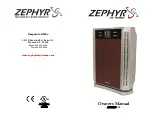
7
Ensure that the refrigeration system is earthed prior
to charging the system with refrigerant.
Label the system when charging is complete (if not
already).
Extreme care shall be taken not to overfill the refri-
geration system. Prior to recharging the system it
shall be pressure tested with OFN. The system shall
be leak tested on completion of charging but prior to
commissioning. A follow up leak test shall be carried
out prior to leaving the site.
14. Decommissioning
Before carrying out this procedure, it is essential that
the technician is completely familiar with the equip-
ment and all its detail. It is recommended good prac-
tice that all refrigerants are recovered safely. Prior to
the task being carried out, an oil and refrigerant sam-
ple shall be taken in case analysis is required prior
to re-use of reclaimed refrigerant. It is essential that
electrical power is available before the task is com-
menced.
a) Become familiar with the equipment and its ope-
ration.
b) Isolate system electrically.
c) Before attempting the procedure ensure that:
Mechanical handling equipment is available, is requi-
red, for handling refrigerant cylinders;
All personal protective equipment is available and be-
ing used correctly;
The recovery process is supervised at all times by a
competent person;
Recovery equipment and cylinders conform to the
appropiate standards.
d) Pump down refrigerant system, if possible.
e) If a vacuum is not possible, make a manifold so
that refrigerant can be removed from various part of
the system.
f) Make sure that cylinder is situated on the scales
before recovery takes place.
g) Start the recovery machine and operate in accor-
dance with manufacturer’s instructions.
h) Do not overfill cylinders. (No more than 80% volu-
me liquid charge).
i) Do not exceed the maximum working pressure of
the cylinder, even temporarily.
j) When the cylinders have been filled correctly and
the process completed, make sure that the cylinders
and the equipment are removed from site promptly
and all isolation valves on the equipment are closed
off.
k) Recovered refrigerant shall not be charged into
another refrigeration system unless it has been clea-
ned and checked.
15. Labelling
Equipment shall be labelled stating that it has been
de-commissioned and emptied of refrigerant. The la-
bel shall be dated and signed. Ensure that there are
labels on the equipment stating the equipment con-
tains flammable refrigerant.
16. Recovery
When removing refrigerant from a system, either for
servicing or decommissioning, it is recommended
good practice that all refrigerants are removed safely.
When transferring refrigerant into cylinders, ensure
that only appropiate refrigerant recovery cylinders
are employed.
Ensure that the correct number of cylinders to be
used are designated for the recovered refrigerant
and labelled for that refrigerant (i.e. special cylinders
for the recovery of refrigerant). Cylinders shall be
complete with pressure relief valve and associated
shut-off valves in good working order. Empty reco-
very cylinders are evacuated and, if possible, cooled
before recovery occurs.
The recovery equipment shall be in good working or-
der to set of instructions concerning the equipment
that is at hand and shall be suitable for the recovery
of flammable refrigerants. In addition, a set of calibra-
ted weighing scales shall be available and in good
working order. Hoses shall be complete with leak-free
disconnect couplings and in good condition. Before
using the recovery machine, check that it is in satis-
factory working order, has ben properly maintained
and that any associated electrical components are
sealed to prevent ignition in the event of a refrigerant
release. Consult manufacturer if in doubt.
The recovered refrigerant shall be returned to the re-
frigerant supplier in the correct recovery cylinder, and
the relevant Waste Transfer Note arranged. Do not
mix refrigerants in recovery units and especially not in
cylinders. If compressors or compressor oils are to be
removed, ensure that they have been evacuated to
and acceptable level to make certain that flammable
refrigerant does not remain within the lubricant. The
evacuation process shall be carried out prior to retur-
ning the compressor to the suppliers. Only electric
heating to the compressor body shall be employed
to accelerate this process. When oil is drained from a
system, it shall be carried out safely.
Note About Fluorinated Gasses
- Fluorinated greenhose gases are contained in hermeti-
cally sealed equipment. For specific information on the
type, the amount and tje CO2 equivalent in tonnes of
the fluorinated greenhose gas (on some models), plea-
se refer to the relevant label on the unit itself.
- Installation, service, maintenance and repair of this unit
mus be performed by a certified technician.
- Product uninstallation and recycling must be performed
by a certified technician.
Warnings
(for using R-290 refrigerant only)
Summary of Contents for KP-35 CP10
Page 20: ......






































